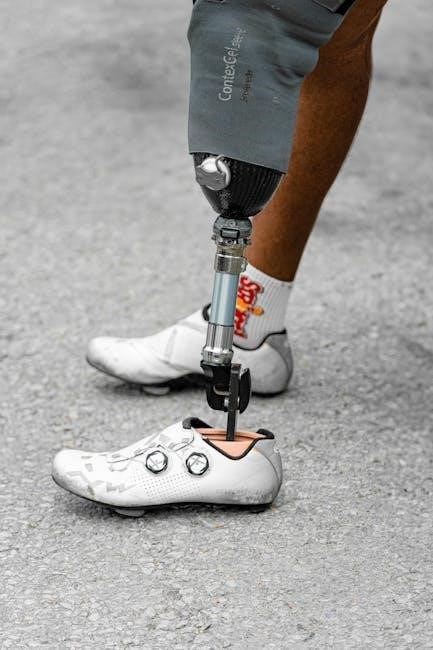Discover the essential guide to selecting the perfect road cycling shoe size. Proper fit ensures comfort‚ performance‚ and prevents discomfort during long rides. Learn how to measure accurately and use brand-specific charts for the best fit.
1.1 Why Proper Shoe Fit is Essential for Road Cycling
Proper shoe fit is crucial for road cycling as it directly impacts comfort‚ performance‚ and injury prevention. Ill-fitting shoes can lead to discomfort‚ numbness‚ or hotspots‚ distracting you during rides. A snug fit ensures efficient power transfer and control‚ enhancing your cycling experience. Poor fit can cause long-term issues like foot pain or discomfort‚ affecting overall enjoyment and performance. Always prioritize accurate sizing to maintain comfort and optimize your cycling efficiency.
1.2 Brief Overview of Road Cycling Shoes
Road cycling shoes are specifically designed for performance and efficiency on the bike. They typically feature stiff soles for optimal power transfer‚ secure closure systems‚ and compatibility with clipless pedals via cleats. These shoes are lightweight and offer a snug fit to minimize foot movement during rides. Unlike regular shoes‚ they prioritize functionality over casual style‚ with features like ventilation for comfort and durability for long-distance rides. The right pair enhances your cycling experience by providing support‚ stability‚ and connection to the bike‚ ensuring both comfort and performance.
Understanding Your Foot Measurements
Accurate foot measurements are crucial for proper cycling shoe fit. Measure length‚ arch‚ and width to ensure comfort and performance. Use brand-specific charts for precise sizing.
2.1 How to Measure Your Foot Length Accurately
To measure your foot length accurately‚ place your foot flat on the ground and use a ruler to measure from the back of the heel to the tip of the longest toe. Ensure the foot is in a natural standing position‚ as this provides the most reliable measurement. For precision‚ measure both feet‚ as they may differ slightly. Always measure while wearing the same thickness of socks you plan to use with your cycling shoes. Compare your measurements to brand-specific size charts for the best fit.
2.2 Importance of Foot Arch and Width in Shoe Fit
The shape of your foot‚ including the arch and width‚ significantly impacts the fit of cycling shoes. A proper fit ensures comfort and prevents discomfort or injury during rides. The arch shape affects how the shoe supports your foot‚ while width determines how snug or roomy the shoe feels. Cycling shoes often have a more precise fit than regular shoes‚ so measuring and understanding your foot’s specific dimensions is crucial. Brands may cater to different foot shapes‚ so comparing your measurements to their size charts will help you find the best fit for optimal performance and comfort.

Differences Between Road Cycling Shoes and Regular Shoes
Road cycling shoes are stiffer‚ lighter‚ and designed for efficiency‚ often featuring cleats for pedal connection. Regular shoes offer more cushioning and flexibility for everyday use.
3.1 Design and Features Unique to Road Cycling Shoes
Road cycling shoes are optimized for performance‚ featuring stiff soles for efficient power transfer and cleats for secure pedal connection. They often include a snug fit‚ breathable materials‚ and lightweight designs to enhance comfort and speed. Many models incorporate advanced closure systems like ratchet or BOA dials for a precise fit. Ventilation is prioritized to keep feet cool during intense rides. Some shoes also offer specialized features like customizable insoles or reinforced arch support‚ catering to different riding styles and preferences. These design elements distinguish road cycling shoes from regular footwear‚ focusing on functionality and rider efficiency.
3.2 How Cycling Shoe Sizing Compares to Regular Shoe Sizing
Cycling shoe sizing often differs from regular shoes‚ as they are designed for a snug‚ performance fit. Cyclists may need to size down by half to a full size compared to their everyday shoes. This ensures minimal foot movement and optimal energy transfer. Additionally‚ cycling shoes frequently feature narrower widths and varying shapes based on brand and model. It’s crucial to consult brand-specific size charts‚ as sizing can vary significantly between manufacturers. Proper fit is essential for comfort and efficiency during rides‚ making accurate sizing a priority for cyclists.

How to Choose the Right Size for Your Road Cycling Shoes
Selecting the right size involves measuring your foot length‚ considering arch type‚ and using brand-specific charts. Ensure a snug fit for optimal performance and comfort during rides.
4.1 Using Brand-Specific Size Charts
Brand-specific size charts are crucial for accurate fit. Each brand may vary in sizing‚ so comparing your measurements to their chart ensures precision. For example‚ Shimano’s chart aligns foot length with EU and US sizes. Some brands offer half sizes or wide fits‚ catering to different foot shapes. Always consult the manufacturer’s guide before purchasing‚ as sizing can differ significantly between brands. This step ensures a snug‚ comfortable fit‚ avoiding discomfort during rides. Proper alignment and support are key to performance and enjoyment.
4.2 Understanding EU vs. US Size Conversions
EU and US shoe sizes differ significantly‚ with EU sizes typically being 1.5 to 2 sizes larger than US sizes. For example‚ a US size 9 often corresponds to an EU 42.5. This variation necessitates careful comparison using brand-specific charts to ensure accuracy. Some brands provide dual sizing‚ simplifying the process. Always verify the conversion to avoid sizing mismatches‚ as even small discrepancies can affect comfort and performance. Accurate conversion ensures a proper fit‚ enhancing your cycling experience with optimal support and efficiency.

Factors Influencing the Fit of Road Cycling Shoes
Foot measurements‚ sock thickness‚ and personal comfort preferences significantly impact shoe fit. Brand-specific designs and varying foot shapes also play a role in achieving optimal comfort and performance.
5.1 The Impact of Socks on Shoe Fit
Socks significantly influence road cycling shoe fit. Thicker socks can make shoes feel tighter‚ while thinner ones provide a more snug fit. Choosing the right sock thickness ensures optimal comfort and prevents blisters. Cycling-specific socks‚ often made of moisture-wicking materials‚ are designed to enhance performance. When trying on shoes‚ wear the same type of socks you plan to use while cycling to get an accurate fit. This small detail can make a big difference in overall comfort and riding efficiency.
5.2 Considering Personal Comfort Preferences
Personal comfort preferences play a crucial role in selecting road cycling shoes. Some riders prefer a snug fit for optimal power transfer‚ while others prioritize a bit more room for comfort during long rides. Factors like toe box space‚ heel tightness‚ and overall shoe stiffness should align with your riding style and personal comfort needs. Considering these preferences ensures a more enjoyable and efficient cycling experience‚ as ill-fitting shoes can lead to discomfort or distraction during rides.
Trying on Road Cycling Shoes
Try on shoes with cycling socks for accuracy. Ensure a snug fit without pressure points. Check alignment and support‚ especially if using cleats‚ for optimal comfort and performance.
6.1 What to Look for When Trying Shoes On
When trying on road cycling shoes‚ ensure a snug‚ comfortable fit. Check for minimal heel movement and a secure feel around the midfoot. The toe box should allow slight wiggle room without pressure. Pay attention to arch support and overall alignment‚ especially if using cleats. Test the shoes with cycling socks for accuracy. A proper fit should balance tightness and comfort‚ avoiding hotspots or restricted movement. If possible‚ simulate pedaling to assess how the shoes feel in action;
6.2 The Best Time of Day to Try On Shoes
The best time to try on road cycling shoes is in the afternoon or evening‚ as feet tend to swell slightly throughout the day. This ensures the shoes will fit comfortably during rides. Wear the same type of socks you plan to use while cycling to get an accurate fit. Trying shoes at this time helps avoid tightness caused by swelling‚ ensuring optimal comfort and performance on the road.
Common Mistakes to Avoid When Buying Road Cycling Shoes
Common mistakes include ignoring snug fit‚ not considering foot shape‚ and assuming sizing consistency across brands. Always try shoes with cycling socks and refer to size charts.
7.1 Ignoring the Importance of Snug Fit
A snug fit is crucial for road cycling shoes‚ as it prevents hotspots and ensures efficient power transfer. Ignoring this can lead to discomfort‚ blisters‚ or reduced performance. Always try shoes with cycling socks and refer to brand-specific size charts to avoid oversized or undersized footwear. A proper fit should feel firm but not restrictive‚ allowing for slight toe movement. Remember‚ cycling shoes are designed to be tighter than casual shoes for optimal support and stability during rides.
7.2 Not Considering the Shape of Your Foot
Overlooking your foot’s shape can significantly impact cycling comfort and performance. Every cyclist’s foot is unique‚ with variations in width‚ arch height‚ and toe shape. Brands design shoes to accommodate different foot types‚ so not considering this can lead to ill-fitting shoes. Ill-fitting shoes cause discomfort‚ blisters‚ and can even hinder power transfer during rides. Always try on shoes‚ ensuring they match your foot shape for optimal comfort and performance.
Different Types of Road Cycling Shoes
Explore various road cycling shoe options tailored to rider preferences. Racing shoes prioritize stiffness‚ while endurance shoes emphasize comfort. Specialty shoes cater to unique riding styles and demands.
8.1 Racing vs. Endurance Shoes
Racing shoes are designed for speed and efficiency‚ featuring ultra-stiff soles and lightweight materials to maximize power transfer. They often have a snug fit and aerodynamic designs. Endurance shoes‚ on the other hand‚ prioritize comfort for long rides with cushioning‚ breathable materials‚ and a more relaxed fit. While racing shoes are ideal for competitive events‚ endurance shoes are better suited for extended tours or training sessions. Both cater to different riding styles‚ ensuring optimal performance and comfort based on the cyclist’s needs and preferences.
8.2 Specialty Shoes for Specific Riding Styles
Specialty road cycling shoes cater to unique riding styles and conditions. Triathlon shoes feature quick-release systems for fast transitions‚ while gravel shoes offer increased durability and traction for off-road adventures. Winter shoes often include insulation and waterproofing for cold-weather rides. Each design addresses specific demands‚ ensuring optimal performance and comfort for niche cycling disciplines. Whether racing‚ touring‚ or tackling rough terrain‚ these shoes are tailored to enhance your cycling experience in specialized scenarios.

Brand-Specific Fit Characteristics
Each cycling shoe brand offers unique fit profiles. For example‚ Shimano shoes often run slightly wider‚ while Sidi shoes are known for their snug‚ performance-oriented fit. Comparing these characteristics helps cyclists choose the best brand for their foot shape and riding style.
9.1 Popular Brands and Their Fit Profiles
Popular brands like Shimano‚ Sidi‚ and Crankbrothers offer distinct fit profiles. Shimano shoes tend to run wider‚ catering to those with broader feet‚ while Sidi shoes are known for a snug‚ performance-oriented fit. Crankbrothers’ Mallet series provides a secure‚ downhill-focused design. Fizik and Specialized also offer tailored fits‚ with Fizik emphasizing a more forgiving toe box and Specialized focusing on adaptive comfort. Understanding these differences helps cyclists match their foot shape and riding style to the best brand for optimal performance and comfort.
9.2 How to Compare Fit Across Different Brands
Comparing fit across brands requires attention to detail‚ as each brand offers unique sizing and shape profiles. Use brand-specific size charts and try shoes on if possible. Consider your foot shape‚ arch type‚ and personal comfort preferences. Some brands‚ like Shimano‚ may fit wider feet better‚ while others‚ like Sidi‚ offer a snugger fit. Pay attention to features like sole stiffness and upper material. Testing multiple brands and models helps identify the best match for your cycling needs and ensures optimal performance and comfort during rides.
How to Break In New Road Cycling Shoes
Start by wearing shoes indoors for short periods to mold to your feet. Gradually increase ride duration to adapt to stiffness and fit.
10.1 Tips for Breaking In Stiff Soles
Breaking in stiff cycling shoe soles requires patience. Start by wearing them indoors for short periods to allow the material to mold to your feet. Use a hair dryer on a low setting to gently heat and soften the soles‚ then walk around to shape them. Gradually increase ride duration to let the soles adapt to your pedaling motion. For optimal comfort‚ consider using insoles designed for cycling to provide additional support and cushioning during the break-in period.
10.2 Avoiding Discomfort During the Break-In Period
To minimize discomfort during the break-in period‚ wear thin‚ moisture-wicking socks to reduce pressure points. Start with short rides and gradually increase duration as the shoes mold to your feet. Ensure proper cleat alignment to avoid strain on your knees or feet. Take breaks to stretch and remove shoes if needed. Consider using insoles or padding for extra cushioning. Remember‚ new shoes need time to adapt‚ so patience is key for achieving long-term comfort and performance.
Maintenance and Care of Road Cycling Shoes
Regularly clean shoes with mild soap and water‚ avoiding harsh chemicals. Dry thoroughly to prevent mold. Store in a cool‚ dry place to maintain shape and durability.
11.1 Cleaning and Storage Tips
For optimal maintenance‚ clean road cycling shoes with mild soap and water‚ avoiding harsh chemicals or abrasive materials. Use a soft brush to remove dirt from crevices. Allow shoes to air dry naturally‚ away from direct sunlight or heat‚ to prevent damage. Store shoes in a cool‚ dry place‚ away from moisture. Consider using shoe trees to maintain shape and prevent warping. Regular cleaning and proper storage extend the lifespan of your cycling shoes‚ ensuring they remain comfortable and functional for future rides.
11.2 When to Replace Your Cycling Shoes
Replace cycling shoes when they show significant wear‚ such as sole damage‚ cleat wear‚ or upper material degradation. If the shoes no longer provide a snug fit or cause discomfort‚ it’s time for a new pair. Typically‚ road cycling shoes should be replaced every 2-3 years or after approximately 5‚000 miles‚ depending on usage. Look for signs like cracks in the sole‚ worn-out cleats‚ or stretched upper materials. Addressing these issues promptly ensures optimal performance‚ comfort‚ and safety during rides.
Choosing the right road cycling shoe size is crucial for comfort and performance. By following this guide‚ riders can ensure a perfect fit‚ enhancing their cycling experience.
12.1 Recap of Key Points for Choosing the Right Size
Proper fit is vital for comfort and performance. Measure foot length accurately‚ use brand-specific charts‚ and consider sock thickness. Try shoes in the afternoon for best fit. Ensure snugness without discomfort‚ and align personal comfort preferences with shoe features; Avoid common mistakes like ignoring foot shape or sizing differences between brands. Prioritize a balance between support and flexibility for optimal cycling efficiency and joy in every ride.
12.2 Final Tips for Optimal Comfort and Performance
Invest in a precise fit by considering both length and width. Gradually break in stiff soles to avoid discomfort. Opt for moisture-wicking socks to enhance breathability. Ensure cleats are properly aligned for efficient power transfer. Regularly clean and store shoes to maintain hygiene and durability. Prioritize shoes with adjustable closures for a customizable fit. Test ride with new shoes to assess comfort and make necessary adjustments. Remember‚ optimal performance starts with happy‚ well-supported feet.

Leave a Reply
You must be logged in to post a comment.